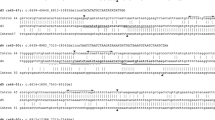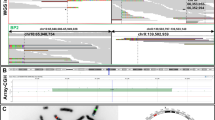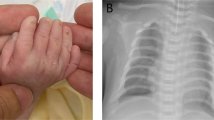Abstract
Emery-Dreifuss muscular dystrophy (EMD) is an X-linked disorder characterized by contractures, progressive muscle weakness and cardiomyopathy1–3. The emerin gene, located in human Xq28, is approximately 2 kb in length, is composed of 6 exons and falls within a 219-kb region that has been completely sequenced4–6. Immediately centromeric to emerin is the 26-kb filamin gene (FLN1), composed of 48 exons and encoding the actin-binding protein 280 (refs 7,8). Flanking this 48-kb FLN1/emerin region are two large inverted repeats, each 11.3 kb, that exhibit >99% sequence identity6. The high level of genomic detail in this region allowed us to characterize the first complete emerin gene deletion mutation that also involved a partial duplication of the nearby FLN1 gene. This rearrangement could be explained by mispairing of the large inverted repeats, followed by double recombination among one set of mispaired repeats and internal sequences. Furthermore, our characterization of this rare DNA rearrangement revealed a more common result of the mispairing of these large inverted repeats7—recombination contained within the inverted repeats leading to the maintenance of repeat sequence homogeneity and inversion of the 48-kb FLN1/emerin region. The presence of this frequent inversion, found in the heterozygous state in 33% of females, helps to explain the discrepancies observed between the genetic and physical map distances in this region of the X chromosome. It also illustrates the biological insights which can be gleaned by sequencing the human genome.
This is a preview of subscription content, access via your institution
Access options
Subscribe to this journal
Receive 12 print issues and online access
$209.00 per year
only $17.42 per issue
Buy this article
- Purchase on Springer Link
- Instant access to full article PDF
Prices may be subject to local taxes which are calculated during checkout
Similar content being viewed by others
References
McKusick, V.A., Mendelian Inheritance in Man (The Johns Hopkin's University Press, Baltimore 1994).
Emery, A.E.H., Emery-Dreifuss Syndrome. J. Med. Genet. 26, 637–641 (1989).
Hopkins, L.C. & Warren, S.T. in Handbook of Clinical Neurobiology. feds Rowland, Eds & DiMauro, S.) 145–160 (Elsevier, Amsterdam, 1993).
Bione, S. et al. Identification of a novel X-linked gene responsible for Emery-Dreifuss muscular dystrophy. Nature Genet. 8, 323–327 (1994).
Bione, S. et al. Identification of new mutations in the Emery-Dreifuss muscular dystrophy gene and evidence for genetic heterogeneity of the disease. Hum. Mol. Genet. 4, 1859–1863 (1995).
Chen, E.Y. et al. Long-range sequence analysis in Xq28: thirteen known and six candidate genes in 219.4 kb of high GC DMA betwen the RCP/GCPand G6PD loci. Hum. Mol. Genet. 5, 659–668 (1996).
Gorlin, J.B. et al. Actin-binding protein (ABP-280) filamin gene (FLN) maps telomeric to the color vision locus (R/GCP) and centromeric to G6PD in Xq28. Genomics 17, 496–497 (1993).
Patrosso, M.C. et al. The exon-intron organization of the human X-linked gene (FLN1) encoding actin-binding protein 280. Genomics 21, 71–76 (1994).
Roth, D.B., Porter, T.N. & Wilson, J.H. Mechanisms of nonhomologous recombination in mammalian cells. Mol. Cell. Biol. 5, 2599–2607 (1985).
Woods-Samuels, P., Kazazian, H.H. & Antonarakis, S.E. Nonhomologous recombination in the human genome: Deletions in the human factor VIII gene. Genomics 10, 94–101 (1991).
Cunningham, C.C. et al. Actin-binding protein requirement for cortical stability and efficient locomotion. Science 255, 325–327 (1992).
Rossitier, J.P. et al. Factor VIII gene inversions causing severe hemophilia A originate almost exclusively in male germ cells. Hum. Mol. Genet. 3, 1035–1039 (1994).
Coyne, J.A., Aulard, S. & Berry, A. Lack of underdominance in a naturally occuring pericentric inversion in Drosophila melanogaster and its implications for chromosome evloution. Genetics 129, 791–802 (1991).
Zetka, M.C. & Rose, A.M. The meiotic behavior of an inversion in Caenorhabditis elegans. Genetics 131, 321–332 (1992).
Dresser, M.E., Ewing, D.J., Harwell, S.N., Coody, D. & Conrad, M.N. logous synapsis and reduced crossingover in a heterozygous paracentric inversion in Saccharomyces cerevisae. Genetics 138, 633–647 (1994).
Ashley, T., Cacheiro, N.L.A., Russell, L.B. & Ward, D.B. Molecular characterization of a pericentric inversion in mouse chromosome 8 implicates telomeres as promoters of meiotic recombination. Chromosoma 102, 112–120 (1993).
Sashi, V. et al. Molecular analysis of recombination in family with Duchenne muscular dystrophy and a large pericentric X chromosome inversion. Am. J. Hum. Genet. 58, 1231–1238 (1996).
King, M. A dual model for speciation by multiple pericentric inversions. Heredity 68, 437–440 (1992).
Wang, L.H., Collins, A., Lawrence, S., Keats, B.J. & Morton, N.E. Integration of gene maps: Chromosome X. Genomics 22, 590–604 (1994).
Rogner, U.C. et al. A YAC clone map spanning 7.5 megabases of human chromosome band Xq28. Hum. Mol. Genet. 3, 2137–2146 (1994).
Willard, H.F. et al. Report of the fifth international workshop on human X chromosome mapping 1994. Cytogenet Cell Genet. 67, 296–328 (1994).
Dausset, J. et al. Centre d'Etude du Polymorphisme Humaine (CEPH): Collaborative genetic mapping of the human genome. Genomics 6, 575–577 (1990).
Filosa, S. et al. G6PD haplotypes spanning Xq28 from F8C to Red/Green color vision. Genomics 17, 6–14 (1993).
Yen, P.H. et al. Frequent deletions of the human X chromosome distal short arm result from recombination between low copy repetitive elements. Cell 61, 603–610 (1990).
Pentao, L., Wise, C.A., Chinault, A.C., Patel, P.I. & Lupski, J. Charcot-Marie-Tooth type 1A duplication appears to arise from recombination at repeat sequences flanking the 1.5 kb monomer unit. Nature Genet. 2, 292–300 (1992).
Lakich, D., Kazazian, H.H., Antonarakis, S.E. & Gitschier, J. Inversions disrupting the factor VIII gene are a common cause of severe haemophilia A. Nature Genet. 5, 236–241 (1993).
Naylor, J.A. et al. Investigation of the factor VIII intron 22 repeated region (int22h) and the associated inversion junctions. Hum. Mol. Genet. 4, 1217–1224 (1995).
Parrish, J.E. et al. A muscle-specific DNase l-like gene in human Xq28. Hum. Mol. Genet. 4, 1557–1564 (1995).
Author information
Authors and Affiliations
Corresponding author
Rights and permissions
About this article
Cite this article
Small, K., Iber, J. & Warren, S. Emerin deletion reveals a common X-chromosome inversion mediated by inverted repeats. Nat Genet 16, 96–99 (1997). https://doi.org/10.1038/ng0597-96
Received:
Accepted:
Issue Date:
DOI: https://doi.org/10.1038/ng0597-96
This article is cited by
-
CRISPR–Cas-mediated chromosome engineering for crop improvement and synthetic biology
Nature Plants (2021)
-
From gene editing to genome engineering: restructuring plant chromosomes via CRISPR/Cas
aBIOTECH (2020)
-
GRSR: a tool for deriving genome rearrangement scenarios from multiple unichromosomal genome sequences
BMC Bioinformatics (2018)
-
Replicative mechanisms for CNV formation are error prone
Nature Genetics (2013)
-
Inverted genomic segments and complex triplication rearrangements are mediated by inverted repeats in the human genome
Nature Genetics (2011)



